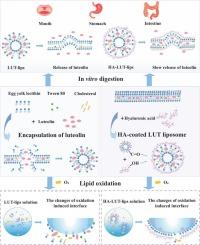Interaction between hyaluronic acid and phospholipid bilayer and its influence on stability and bioavailability of luteolin-loaded liposomes
IF 8.2
1区 农林科学
Q1 CHEMISTRY, APPLIED
引用次数: 0
Abstract
The poor solubility of luteolin limits its food applications, and while liposomes offer a potential delivery solution, their phospholipid bilayer membranes are unstable. To overcome these dual challenges, this study developed hyaluronic acid (HA)-coated luteolin liposomes (HA-LUT-lips). HA-LUT-lips exhibited a core-shell structure, high encapsulation efficiency, and good dispersibility. Fourier transform infrared spectroscopy (FTIR) confirmed HA interacted with liposomes via hydrogen bonds, while Raman spectroscopy (RS) showed HA reduced membrane fluidity and enhanced lipid lateral packing. Thermogravimetric (TG) analysis and differential scanning calorimetry (DSC) revealed that HA-LUT-lips were more thermally stable than LUT-lips. HA coating also enhanced ionic strength and storage stability, slowing luteolin release during simulated digestion. HA coating can resist the oxidation of liposomes and delay the leakage of luteolin. These findings suggest HA-coated liposomes were a promising delivery system for luteolin in functional foods and nutritional enhancers.

透明质酸与磷脂双分子层的相互作用及其对木犀草素脂质体稳定性和生物利用度的影响
木犀草素的溶解度差限制了它在食品中的应用,虽然脂质体提供了一种潜在的递送解决方案,但它们的磷脂双层膜是不稳定的。为了克服这些双重挑战,本研究开发了透明质酸(HA)包被木犀草素脂质体(HA- lut -lips)。HA-LUT-lips具有核壳结构,封装效率高,分散性好等特点。傅里叶变换红外光谱(FTIR)证实了透明质酸通过氢键与脂质体相互作用,而拉曼光谱(RS)显示透明质酸降低了膜的流动性,增强了脂质横向堆积。热重分析(TG)和差示扫描量热分析(DSC)表明HA-LUT-lips的热稳定性优于LUT-lips。透明质酸涂层还增强了离子强度和储存稳定性,减缓了模拟消化过程中木犀草素的释放。透明质酸涂层可以抵抗脂质体的氧化,延缓木犀草素的渗漏。这些发现表明ha包被脂质体是一种很有前途的木犀草素在功能性食品和营养增强剂中的输送系统。
本文章由计算机程序翻译,如有差异,请以英文原文为准。
求助全文
约1分钟内获得全文
求助全文
来源期刊

Food Chemistry: X
CHEMISTRY, APPLIED-
CiteScore
4.90
自引率
6.60%
发文量
315
审稿时长
55 days
期刊介绍:
Food Chemistry: X, one of three Open Access companion journals to Food Chemistry, follows the same aims, scope, and peer-review process. It focuses on papers advancing food and biochemistry or analytical methods, prioritizing research novelty. Manuscript evaluation considers novelty, scientific rigor, field advancement, and reader interest. Excluded are studies on food molecular sciences or disease cure/prevention. Topics include food component chemistry, bioactives, processing effects, additives, contaminants, and analytical methods. The journal welcome Analytical Papers addressing food microbiology, sensory aspects, and more, emphasizing new methods with robust validation and applicability to diverse foods or regions.
 求助内容:
求助内容: 应助结果提醒方式:
应助结果提醒方式:


